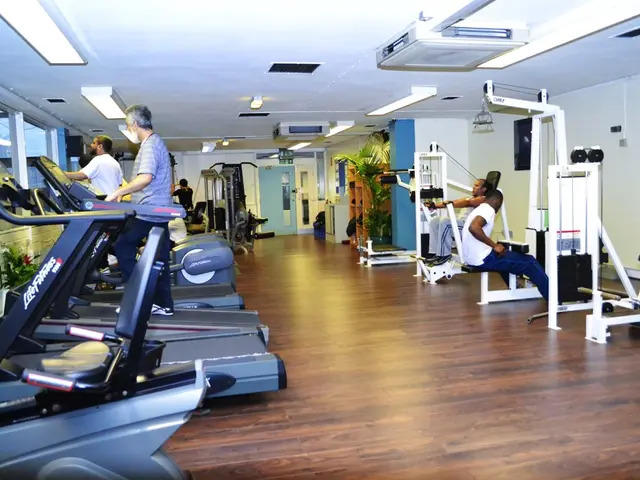Common tactics for alleviating headaches include:
Heel Ache: All About Plantar Fasciitis
Feeling a stab of pain on the bottom of your heel? You might be dealing with plantar fasciitis, a common condition causing inflammation in the thick band of tissue ruling your heel-to-toe connection - the plantar fascia. This laidback guide to plantar fasciitis is packed with the scoop you need on symptoms, causes, and strategies to kick your discomfort to the curb.
Jump to:
Key Sections
- Plantar Fasciitis: Breaking it Down
- Symptoms: What to Expect
- Understanding the Causes
- Diagnosing Plantar Fasciitis
- Treatment: Find Your Relief
- Supportive Shoes and Orthotics
- Exercise: Strengthen and Stretch
- Ice and Rest
- Medication: Over-the-Counter and Prescription
- Splints: Nighttime Support for Morning Pain
- Injections: Corticosteroids and PRP
- Extra Help: ESWT and Tissue Repair Techniques
- The Last Resort: Surgery
- Lifestyle and Home Remedies
- Prevention: Protect Your Feet Ahead of Time
Plantar Fasciitis: The Lowdown
Marked by irritation and inflammation in the plantar fascia, plantar fasciitis strikes the thick band running from your heel bone to your toes, playing a role in shock absorption and supporting each step you take. However, overuse, poor footwear, or underlying structural issues can put extra stress on this band, leading to tears and inflammation, causing heel pain.
Symptoms: What to Expect
Plantar fasciitis symptoms usually center around a sharp pain on the bottom of your heel, more intense in the morning or after a long period of rest. Sometimes, you'll feel a burning or aching sensation on the bottom of the foot, spreading out from the heel. Climbing stairs might become a challenge due to the heel stiffness, and pains might worsen after extensive activity.
Causes: What's Behind the Pain?
While the exact cause of plantar fasciitis remains a mystery, several factors can crank up the risk of developing the condition. Age plays a key role, with plantar fasciitis commonly affecting individuals between 40 and 60 years old. Activities putting an excessive toll on the heel and plantar fascia, like long-distance running, ballet dancing, and aerobic workouts, can contribute to the problem. Structural issues like flat feet or high arches can also affect weight distribution, putting added stress on the plantar fascia. Other risk factors include obesity, jobs requiring prolonged standing or walking on hard surfaces, and tight Achilles tendons.
Diagnosing Plantar Fasciitis
To nail down a plantar fasciitis diagnosis, your doctor will perform a physical exam, checking for tenderness in your foot and focusing on the precise location of your pain. This evaluation helps rule out other possible explanations for your symptoms. In some situations, imaging tests like X-rays, MRIs, or ultrasounds may be necessary to assess the structures and tissues in your foot for a definitive conclusion.
Treatment: Find Your Relief
Many cases of plantar fasciitis can be managed using conservative measures. The following treatment options are typically recommended:
Supportive Shoes and Orthotics
Lacing up in shoes with good arch support, cushioning, and shock absorption helps distribute pressure evenly across your foot. Custom-made orthotics may join the party to further support and take the edge off the plantar fascia.
Exercise: Strengthen and Stretch
Stretching exercises targeting your plantar fascia, Achilles tendon, and calf muscles can help alleviate pain and enhance mobility. Guided by a physical therapist, you'll learn the right exercises for stretching these areas and strengthening the connected muscles.
Ice and Rest
Applying ice to the affected area for 15 minutes several times a day can help soothe pain and swelling. Giving your foot some rest and avoiding activities that worsen your symptoms is crucial.
Medication: Over-the-Counter and Prescription
Over-the-counter NSAIDs like ibuprofen or naproxen sodium can provide temporary pain relief and tackle inflammation associated with plantar fasciitis. Your doctor may suggest opioids or stronger medication if necessary.
Splints: Nighttime Support for Morning Pain
Wearing a splint that keeps the plantar fascia and Achilles tendon in an extended position throughout the night can promote stretching and mitigate morning pain and stiffness.
Injections: Corticosteroids and PRP
In some cases, your doctor may propose injecting a corticosteroid medication into the affected area for temporary pain relief and to combat inflammation. Platelet-rich plasma injections derived from your blood might also be employed to accelerate tissue healing.
Extra Help: ESWT and Tissue Repair Techniques
ESWT, or extracorporeal shock wave therapy, employs sound waves to stimulate healing. This technique is typically reserved for tough-nut cases of plantar fasciitis that haven't responded to other conservative treatments. Ultrasound tissue repair is a minimally invasive technology that uses ultrasound imaging to guide a needle-like probe into the damaged plantar fascia tissue, breaking up the damaged sections before suctioning them out.
The Last Resort: Surgery
Surgery is rarely necessary for plantar fasciitis but may be suggested for extreme cases that don't respond to conservative treatment. Possible surgical options include releasing the plantar fascia from the heel bone or releasing tension in the band to reduce inflammation.
Lifestyle and Home Remedies
In addition to medical interventions, taking on lifestyle changes and home remedies can help alleviate symptoms and prevent plantar fasciitis from recurring. Consider incorporating these practices into your routine:
Maintain a Healthy Weight
Extra pounds can add additional weight on your plantar fascia, increasing the chances of developing or worsening plantar fasciitis. Shedding excess weight can help take the pressure off your feet.
Choose supportive shoes
Treat your feet to shoes boasting low to medium heels, thick soles, good arch support, and ample cushioning. Ditch worn-out athletic shoes that no longer offer enough support.
Change physical activities
If you're into high-impact activities like intense running or tough aerobics, switch to low-impact options like swimming or cycling to reduce plantar fascia stress.
Apply ice and stretch regularly
Freeze the affected area for 15 minutes several times a day and make stretching an integral part of your routine to alleviate pain and swelling.
Plantar Fasciitis Prevention Strategies
Stopping plantar fasciitis in its tracks involves proactive measures like lifestyle adjustments, exercise, and proper footwear. Consider these strategies:
Wear appropriate footwear
Secure shoes that provide adequate arch support, cushioning, and shock absorption. For individuals with foot deformities like high or flat arches, consulting a podiatrist for customized footwear is a wise move.
Increase physical activity gradually
If you're new to an exercise regimen or are stepping up the intensity, do so in small increments to give your body, including your feet, a chance to adapt before overdoing it.
Maintain a healthy weight
Keeping a trim waist helps reduce strain on your feet, minimizing the risk of plantar fasciitis.
Stretch before and after exercise
Include stretches for the calf muscles, Achilles tendon, and plantar fascia in your warm-ups and cool-down routines to prepare your muscles and tendons for activity and reduce your odds of injury.
Listen to your body
Pay close attention to foot pain or discomfort. If signs of injury persist, heed the warning signals and seek medical advice, rather than pushing through the pain.
Embrace knowledge, patience, and a partnership with your healthcare provider to vanquish plantar fasciitis and safeguard your feet. Happy heels to you!
- Partaking in science-backed exercise routines focusing on the calf muscles, Achilles tendon, and plantar fascia, as recommended by health-and-wellness professionals, can aid in alleviating plantar fasciitis pain and enhancing mobility.
- To maintain foot health, individuals should consider adopting a fitness-and-exercise regimen that includes low-impact activities such as swimming or cycling, which place less stress on the plantar fascia compared to high-impact activities like running.








